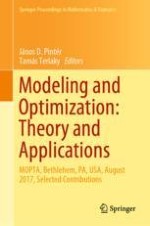2019 | OriginalPaper | Chapter
Smooth Minimization of Nonsmooth Functions with Parallel Coordinate Descent Methods
Authors : Olivier Fercoq, Peter Richtárik
Published in: Modeling and Optimization: Theory and Applications
Publisher: Springer International Publishing
Activate our intelligent search to find suitable subject content or patents.
Select sections of text to find matching patents with Artificial Intelligence. powered by
Select sections of text to find additional relevant content using AI-assisted search. powered by
